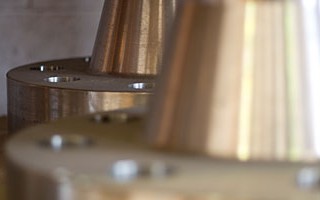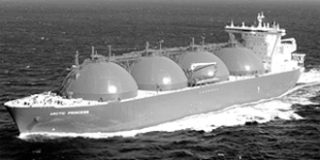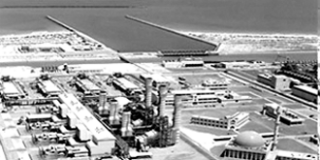FLANGES
Special Piping Materials can source and supply a range of pipe flanges that are made from premium quality materials including Duplex, Super Duplex and 6% Moly. All our flanges have been tested to the very highest of standards.

Flanges
Special Piping Materials can source and supply a range of pipe flanges that are made from premium quality materials including Duplex, Super Duplex and 6% Moly. All our flanges have been tested to the very highest of standards.
A flange is an external or internal ridge between two pipes that provides a method of connecting pipes, valves, pumps and other equipment to form an overall piping system.
In many applications, engineers need to find a way to close off a chamber or cylinder in a very secure fashion, usually because the substance inside must differ from the substance outside in composition or pressure. They do this by fastening two pieces of metal or other material together with a circle of bolts on a lip. This “lip” is a flange.
Flanges can also provide easy access for cleaning, inspection or modification and pipes with flanges can be assembled and disassembled easily. Flanges tend to be either welded or screwed into place.
Pipe flanges are manufactured in a variety of different materials. The material of a flange is usually set by the choice of the pipe meaning that the flange matches the material of the pipe, whether that is Duplex, Super Duplex, Stainless Steel, Nickel Alloy or 6% Moly.
Here at Special Piping Materials, we carry many different flanges in stock in our warehouses around the world, these include:
- Weld Necks
- Slip-on
- Blinds
- Lap Joint
At Special Piping Materials, alongside finished flanges, we also carry a stock of Semi-Finished flanges in all our warehouses around the world – Perth, Singapore, Dubai, Rio De Janeiro, Houston, Manchester and Aberdeen.
Semi-Finished Flanges are unfinished stainless-steel flanges that have already undergone some machining processes but are not the complete article yet. These flanges mean that we can quickly manufacture the exact type of flanges that our customers require as they can be machined to very precise specifications.
What are the different types of Pipe Flanges?
Here at Special Piping Materials we supply many different types of flanges, some of which we have detailed below. Each of the below flanges can be either Ring-Type Joint Flanges or Raised Face Flanges:
Ring-Type Joint vs Raised Face
Ring-Type Joint Flanges are often thought to be one of the most efficient flanges in pipeline design. Instead of using a gasket between connecting flanges, Ring-Type Joint Flanges have grooves cut into their faces with steel ring gaskets. When the bolts connecting the flanges are tightened, the gasket is compressed between the flanges into the grooves. This, in turn, creates a an extremely tight and leak-proof, metal-to-metal seal.
The grooves and gasket must stay aligned throughout the operating cycle in order for the seal to remain intact. This is especially important if you are flanging together different metals, for example stainless steel and carbon steel.
A benefit of using a Ring-Type Joint Flange is that the groove within the flange ensures the ring centres itself when the bolts are tightened. This also means it is self-actuating – so the sealing pressure increases as the process pressure increases.
These days, Ring-Type Joint Flanges are often used in oil fields on drilling and completion equipment but can also be found on valves and pipework assemblies, along with high-integrity pressure vessel joints.
As the alternate product to Right-Type Joint Flanges, Raised Face Flanges are commonly used in process plant applications and are easy to identify; As the name suggests, the gasket surface is raised above the bolting circle face. This design of face type means that a Raised Face Flange can be used with a wide combination of gasket designs such as metallic composites and flat ring sheet types.
A Raised Face Flange has a very specific purpose; To concentrate more pressure on a smaller gasket area and therefore increase the joint’s ability to contain the pressure.
It is a very versatile flange and can be used in almost all applications in high and low pressures and temperatures meaning that Special Piping Materials regularly supplies this type of flange to our customers.
Weld Neck Flanges
A Weld Neck Flange (which can also be known as a high-hub flange or a tapered hub flange) consists of a circular fitting with a protruding rim around the circumference. Weld neck flanges are usually forged and then are typically butt-welded to a pipe which successfully transfers stress away from the flange and onto the pipe instead.
Weld Neck Flanges are suitable for use in hostile environments that have extremes of temperature, pressure or other sources of stress. This type of flange has been used successfully at pressures up to 5,000psi.
Blind Flanges
Essentially, a Blind Flange is a plate for covering or closing the end of a pipe to block off a section of pipe or a nozzle on a vessel that is not used. It also allows easy access to the interior of a line or vessel if it needs to be reopened after it is sealed.
It is not unusual for a Blind Flange to block off a nozzle for pressure tests in a plant, or simply because not all of the nozzles within the piping system are required at all times.
Blind Flanges, just like standard pipe flanges, can either be raised face (RF) or flat faced (FF).
Blind Flanges are used in all manner of industries such as petrochemical, pipe engineering, public services & water works.
Slip-On Flanges
A Slip-On Flange slips over the pipe, or possibly elbow, that they are being joined to. To allow this to happen, they are specifically manufactured so that their inside diameter is slightly bigger than the pipe’s outside diameter. Slip-On Flanges are then connected to the pipe via a ‘fillet weld’ at the top, bottom, inside and outside of the flange which ensure the strength of the join.
Slip-On Flanges can be found with both a raised or a flat face and are usually easier to align than a weld neck flange. This flange is ideal for low pressure applications
Lap Joint Flanges
Lap Joint Flanges consist of two parts; A stub end and the backing flange. A pipe is usually welded to the Stub End via a gasket and then the backing flange is not welded or fixed in any way which means it is free to rotate around the stub end for proper alignment with whatever it is joining to.
If your piping system requires frequent dismantling for inspections or cleaning, then a Lap Joint Flanges should be considered. This is because they give the ability for the flange to swivel around and to align bolt holes which simplifies the assembly of large diameter or unusually stiff piping.
Lap Joint Flanges are typically seen in low pressure applications and are considered to be not suitable when there is likely to be high loads on the flange.
Quality Control
Our Steel Pipe Flanges are manufactured in accordance with the American Society for Testing & Materials (ASTM) Standards as follows:
- ASTM A182
- B444
Here is a full list of the flanges that we stock, in a range of different materials:
- Super Duplex (both F55 and F53)
- Duplex (F51 / F60)
- 6% Moly (F44)
- Nickel Alloys (Alloy 400, 625, 800, 825, etc)
- Stainless Steels (316L, 304L, 904L, 310, 321, etc)
And the dimensions we stock for flanges are in accordance with:
- ANSI B16.5
- ANSI B16.47
- BS EN 1092-1
- API 6A (wellhead equipment)
- ANSI B16.36 (orifice flanges)
In stock we have the following sizes and pressure classes of flange available:
- ½” to 10” 150lbs – 2500lbs
- 10” to 24” 150lbs and 300lbs
- All wall thicknesses are available utilising semi-finished products
Due to our close relationships with specialist Mills, we can also source and supply any size any wall thickness required by our clients, as well as source particular fittings to fit within specific drawings.
Special Piping Materials and Flanges
Special Piping Materials is able to source the best precision-engineered weld-neck, blind, slip-on and lap joint flanges from manufacturers across the world. They are used in all manner of industries such as petrochemical, mining, public services & water works.
All the products that we source and supply are fully tested to international standards meaning that our customers can be safe in the knowledge that they are buying high quality and reliable products. Speak to one of our global sales teams today to find out more about the specialist flanges we can supply.
All Posts, Our People & Offices, UK
At Special Piping Materials (SPM), our success is built on the dedication and expertise of our global teams. Each office plays a vital role in supporting clients across the energy, petrochemical, and industrial sectors, ensuring ... Read More
All Posts, Insights & Views, Stainless Steel
At Special Piping Materials (SPM), innovation, quality, and sustainability are central to everything we do. As industries across the globe work to reduce carbon emissions and operate more responsibly, the materials used in piping systems ... Read More
All Posts, Houston, Our People & Offices
At Special Piping Materials (SPM), our teams across the world work collaboratively to deliver high-quality piping solutions to clients in the energy, mining, and industrial sectors. Our Texas office plays a crucial role in supporting ... Read More
BROCHURE
All Stock held by Special Piping Materials tested in accordance with respective ASTM standards.



 Português do Brasil
Português do Brasil![[:en]Products[:pt]PRODUTOS[:]](https://specialpipingmaterials.com/wp-content/uploads/2015/11/Products-1300x250.jpg)






